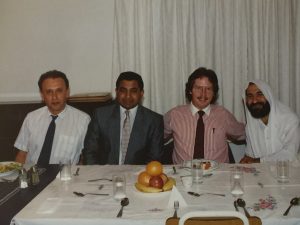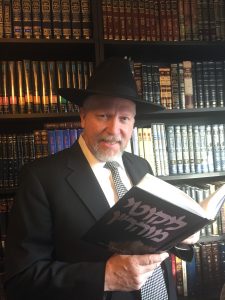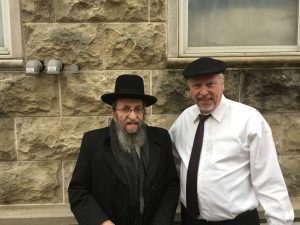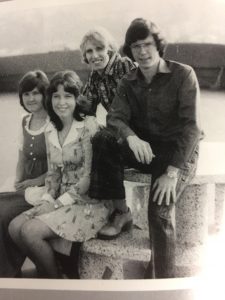A Minister’s Journey to Judaism
Having never even heard of Judaism until he was in the sixth grade, Gavriel Sanders has vivid recollections of visiting classmate Martin Shapiro’s home in the mid-sixties. It was a noisy place that smelled as if cabbage was perpetually cooking, punctuated by Mrs. Shapiro’s New York-accented shouts to her son Harvey to “go study your Hebrew.” At the time, Sanders had no idea what exactly Hebrew was or why anyone would want to study it.
Sanders was born in Atlanta to a Baptist father and a Catholic mother who divorced before his third birthday. With no religious influence in their lives, his parents were what Sanders calls “Christians at risk” and his formative years were spent bouncing from one location to another, switching schools every year. Having called Georgia, Florida, and Texas home at one point or another by the time he was 15, Sanders dropped out of high school and hitchhiked his way from Dallas to California. His only knowledge of religion came from a relatively short stint in Catholic school, where G-d was portrayed as fire breathing and filled with anger, creating an association in his mind between G-d and Godzilla, whose commonalities seemed to extend far beyond the fact that their names both started with the same three letters.
Living on the streets of Huntington Beach, Sanders found free meals nearby, with day-old sandwiches distributed by Christian missionaries after a relatively short inspirational lecture. He was invited to church by a group of clean-cut young missionaries and asked to dinner by the youth pastor, Reverend Dave, where he enjoyed the warm and welcoming environment. And when a visiting missionary asked for volunteers to spread salvation throughout the world during a weekly sermon, Sanders discovered himself standing on his feet, answering the call to become a missionary.
Within a year, Sanders was back in California. A gifted orator who sincerely believed he was offering lost souls eternal salvation, Sanders was hugely successful, sowing seeds of doubt and uncertainty and pitching Christianity as the only answer. Appealing to people who were hungry or hurting with spiritual marketing, and promising stress-free lives to college students during exam time, Sanders spent more than 20 years “saving souls.”
With a degree in theology from Bible school in his pocket and a burning thirst to learn Hebrew to better convince Jews to accept the “Messiah” that they had rejected nearly 2,000 years earlier, Sanders went to Israel as a student of the Hebrew language in 1977. What should have been a six-month stint in ulpan on an irreligious kibbutz was cut considerably shorter after he began having religious discussions with his classmates.
“We had vocabulary for dialoging with Jews, telling them that by believing in Yeshua as the Jewish Messiah they would become completed, Messianic, fulfilled Jews, which would also fill the holes in their souls and give them a divine sense of purpose,” says Sanders.
While it may not have been a dati kibbutz, Sanders’ persuasive efforts still made waves. He was nearly deported from Israel for his missionizing efforts and was relocated to another kibbutz to finish ulpan with a stern warning to avoid all theological discussions. He left Israel and was subsequently blacklisted by the Misrad Hapnim, and he began having doubts, wondering if his faith was true because he believed it, or if he believed in his faith because it actually was true. Sanders threw himself into his missionary work with increased vigor to combat the gnawing uncertainties, all the while planning his next trip to Israel, which had inexplicably captured his heart.
It was clear to Sanders that the Israeli government would never allow him to lecture about religion, so he came up with Plan B – returning to Israel as a teacher of English. He went to school to learn linguistics and arrived back in the country intending to use English to forge connections with students with an ultimate goal of furthering his missionary work. The Israeli police was ready for him, detaining him at Ben Gurion Airport for a nine-hour interrogation before putting him on the next flight out and it was nine harrowing months before he obtained official permission to return. Once settled in Jerusalem with a missionary family, Sanders found work in private schools before eventually being hired to teach English in Israeli public schools. It was working with 5th and 6th graders, who he described as “the toughest teachers ever,” that Sanders realized that studying biblical Hebrew would give him a greater ability to connect the ancient dots between Christian quotations and the original Jewish scriptures, enhancing his soul-saving efforts as an evangelical minister.
But Sanders’ plan of using Tanach as a Christian missionary tool backfired. The more Hebrew he learned, the more he realized that the proof he had been looking for linking the New Testament to the Old didn’t exist. The original Hebrew had been mistranslated, passages had been taken out of context and other “proof texts” appeared to be totally fabricated; no matter how hard Sanders tried to reconcile his findings with everything he had been taught, there was no way to add two and two to equal four. Disturbed and frustrated, he left Israel in 1984 with more questions than answers, once again throwing himself into his missionary activities as a means of getting himself back onto solid ground.
It was two years later while Sanders was working at a church in Southern California with a membership of 10,000, including influential elected officials, celebrities and the crème de la crème of the music world, that another major crack appeared in the foundation of Sanders’ life. Having just returned from three and a half years in Israel, Sanders was tasked with attending a counter-missionary rally at the UCLA Chabad house. Donning a tiny kipa sruga acquired in Tzefas and seating himself in the front row, Sanders heard three erudite rabbis explaining in clear, logical terms, how everything he had believed in for decades was nothing but false advertising. He left the rally filled with more doubt than ever before and a copy of The Jew and the Christian Missionary tucked under his arm
“I would sit in my church office for hours reading the Jewish response to Christian fundamentals and it was one hit of the wrecking ball after another on the wall of my Christian faith,” recalls Sanders. “This was my life – I had everything invested here.”
Sanders had been poised to take on significant new duties as a pastor and educator in adult education but he resolved to leave the church completely, a parting that he described as “very ugly and very public.” He floundered for several years, eventually landing a job teaching English to Bedouin recruits at the Royal Saudi Naval Forces Technical Institute of Naval Studies in Saudi Arabia. With his charm, charisma and rapidly expanding Arabic vocabulary, Sanders connected with his students, but eventually Saudi naval intelligence suspected he had a connection to Israel and sent him packing.

By 1992 Sanders was back in California. It was a college professor friend who suggested that he learn more about Judaism, given his love for Israel, its language, its food, its culture, its poetry and its people. Responding that he had no idea how to proceed, Sanders was told to open up the Yellow Pages, an act that forever changed the trajectory of his life.
His odyssey through the local phone book had Sanders speaking to the rabbi at Congregation Shir Ha-Ma’alot in Irvine about the possibility of conversion. He was welcomed warmly and joined a newly formed nine month long adult education class that would culminate with both a bar mitzvah class and a Reform conversion. The then-ponytailed Sanders enjoyed everything about services at Shir Ha-Ma’alot, from the guitarist accompanying the Friday night davening to the warm heart rabbi passing around the microphone asking people to share their thoughts.
“I remember the first Friday night service, I sat there and I cried because it was so stirring,” said Sanders. “When we started davening words in the siddur for Maariv, the beautiful language, even so much hashkafah and mesorah had been purged from it.”
In a nod to his love of Israel’s northern country, Sanders took on the name Ben Galil at his 1996 bar mitzvah. The 16 members of the class – three men and thirteen women -were called up to the Torah for their aliyahs followed by a post-bar mitzvah celebration at a non-kosher Lebanese restaurant. His extensive biblical knowledge had Sanders tapped to give Torah study classes just six months later, coming to Shir Ha-Ma’alot on Shabbos mornings, parking his pickup truck, turning on the lights and making coffee for the eclectic group that showed up.
“We talked about if Moses had ever existed and if giving the Torah at Mount. Sinai had actually happened; perhaps it was a communal hallucination?” said Sanders. “We would sit around discussing the parashah and why it didn’t apply to us and feeling sorry for the crazy Orthodox Jews who cling to antiquated ways that keep them separate from modern society.”
But the more Sanders learned, particularly after attending a Discovery seminar, the more he realized that there were still parts of the Bible that he knew nothing about.
“I finally realized that if Judaism was a house then I was just living on the porch and I wanted more,” said Sanders. “I spoke to a friend of mine about my spiritual appetite and she directed me to a place with a daily minyan. I was shocked – who knew this existed in Irvine, California?”
Sanders found the Chabad house where the rabbi tactfully informed him that he couldn’t be counted for a minyan and explained that having a Reform conversion was like having a Macy’s card – it worked only in one store and it was clear to Sanders that he needed a conversion that was more akin to a Visa card, providing him with global access to the tribe. He divided his time between the Chabad minyan, a nearby Modern Orthodox shul and the Reform temple and made his first visit to the Rabbinical Council of California, hoping to be accepted as a ger tzedek.
Not surprisingly, the RCC politely rebuffed Sanders after tactfully reminding him that having already left one major religion, he might not be the best candidate for Torah Judaism and advised him to come back in three months if he was still interested. Sanders learned that he had to experience at least a full year of Jewish life before converting on his second trip to the RCC, who gave him their conditional acceptance along with a daunting list of topics to master along with the phone number of a geirus rebbe.
Sanders tackled his homework with enthusiasm, relocating to be closer to the Chabad shul and making a weekly 50-mile round trip to Los Angeles to hang out where the frum crowd did. At one Shabbos meal arranged for him by a local rabbi, Sanders struggled through zemiros along with his fellow diners and then found himself asked to lead bentshing. Having no knowledge of what he was being asked to do, but assuming it was a ritual involving a bench, Sanders replied sheepishly, “but I’m sitting on a chair!”
As the months went by, Sanders yearned to light the Chanukah menorah as a full Jew. After a thorough farher by the beis din, he entered the mikvah on the 23rd day of Kislev as Mark Wynn Sanders and emerged as Gavriel Aryeh, a name he chose to symbolize the dominance of spirituality in man’s constant battle between his existence in this world and his eternal life in the world to come.

As a newly minted member of Klal Yisrael, Sanders was immediately drafted to fight for the other side, taking on the role of education director at Los Angeles office of Jews for Judaism where he headed to the front lines of anti-missionary work and wrote grants. He migrated to Far Rockaway in the summer of 2000, and spent 10 years at ArtScroll, joining Rabbi Meir Zlotowitz z’l, Rabbi Nosson Scherman yblc’t and Rabbi Sheah Brander on their mission to open up Torah and yiddishkeit to the masses.
“It was such a steeping experience, such an education, to be working with people who were being moser nefesh to be marbitz Torah,” observed Sanders.
During his tenure at ArtScroll, Sanders worked with many prominent personalities including Rabbi Paysach Krohn, Rabbi Mordechai Becher and Rebbetzin Esther Jungreis a’h, who adopted Sanders as his “Torah mommy,” something he described as “a very critical piece of the social pie for someone who has no family.” After moving on to various business ventures, Sanders accepted a job as a Hebrew language teacher at a large Long Island yeshivah, where he has also coordinated language acquisition strategies. Being able to share his passion for the Hebrew language with students is an effort that comes from the heart for Sanders, who is pained to see how anemic instruction is disconnecting students from lashon hakodesh.
“We want kids to daven with no idea what they are saying,” observed Sanders. “We give them primitive literacy, sounding out syllables, but no intellectual satisfaction of understanding. They don’t know, it doesn’t make their way to their heart. Absence doesn’t make the heart grow fonder – in yiddishkeit, absence makes the heart go wander.”

Sanders hasn’t been shy about sharing his experiences with the world at large and in addition to speaking at more than 300 venues and producing The Gavriel Sanders Show on the Talkline Communications Network and Mah Nishmah with Gavriel on Arutz Sheva, he has collaborated with Nachum Segal and with Tovia Singer on his Tenak Talk live video Tanach broadcasts. He also does voiceover work and on-hold system messages and is creating a workshop to share the language that changed his life with the world.
“Hebrew became a new pair of glasses for me, opening up portals of perception that gave me a very different view of what I thought was the truth,” remarked Sanders. “Hebrew for me was the gateway to everything I am today.”
After a lifetime of exploration, Sanders understands that his many experiences have brought him to where he is today and he appreciates how the many pieces of his personal puzzle fell together in a way he never could have predicted.
“I can only have hakaras hatov for the path that led me to where I am,” noted Sanders. “Each of these things may have seemed unconnected at the time, but looking back, it’s clear that everything was being orchestrated from above. I started this journey as a dare to myself, going to a Reform congregation and taking Judaism out on a test drive. Baruch Hashem, I am still driving the car.”

Sandy Eller is a freelance writer who writes for numerous websites, newspapers, magazines and private clients. She can be contacted at sandyeller1@gmail.com.
You must be logged in to post a comment.